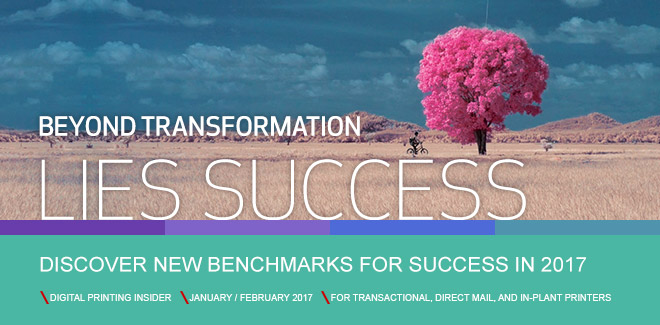Transformation 3.0: Three Key Considerations for Success
Success in 2017 will require print service providers (PSPs) to consider the following three questions that are a benchmark for transformation in today’s ever-changing market:
- Do we have the right technological infrastructure in place to support profitable growth in the future?
- Are we focused on the right application opportunities to sustain and grow our business?
- Have we implemented effective business practices to drive success?
Each year, InfoTrends’ analysts present predictions about the pivotal trends that will shape the future. To follow is a summary of the top trends excerpted from a longer report that will help guide your planning as we move through 2017.
Transformation Requires the Right Technological Investments
The world around us is becoming increasingly digitized, and every industry must find ways to best integrate new technologies into its operations. When it comes to harnessing new technologies, the stakes are high for PSPs. A poor investment can be detrimental to a business, but making the right move can vault a company ahead of its competitors.
In the year ahead, market leaders will focus their printing technology investments in the following areas:
Inkjet and its impact on the growth of digital printing.
Despite ongoing threats from digital media alternatives, print will continue to play a major role in the communications mix. It is important to understand that the value of print hasn’t diminished in today’s digital age—it has simply changed. InfoTrends expects global digital production color volumes to approach 895 billion impressions in 2020, with inkjet representing 60% of total digital color volume.
Which technological investments will you make in the New Year?
The growing digital large format printing market.
Making an investment in large format makes good business sense. InfoTrends projects that production large format print volume in millions of square meters will experience a compound annual growth rate (CAGR) of 13% between 2015 and 2020.
Investments in customized communication solutions that better support customers.
During 2017, PSPs of all sizes will need to rethink their position within the customer communication value chain. There are a number of software tools that PSPs should consider to help transform print from a commodity to an integral part of the customer experience. These software-based solutions are designed to drive better experiences and engagement through personalized, relevant, and timely communications at each point of a business-customer interaction.
Continuing software investments to drive super-efficiency.
A continued focus on software investments will drive super-efficiency so that service providers can lower costs while increasing margins. Although the overall emphasis needs to be on adding value to print and driving increased margins, service providers still understand the importance of making the right investments to reduce production costs and improve overall manufacturing efficiency.
An increased focus on emerging technologies.
As we make our way through 2017, three technologies that are worth watching include augmented reality (AR), direct-to-object printing, and 3-D printing.

Transformation Requires the Right Application Opportunities
The world of print is driven by applications, and demand for certain applications changes over time due to growth in usage, electronic replacement, personalization, and the move to shorter runs. In 2017, service providers that focus on the following areas will have a competitive edge:
High-growth applications are driving pages and revenue.
InfoTrends projects that overall digital print volumes in the United States will increase by 4.0% through 2020, but some applications are expected to outgrow that rate quite noticeably. The application with the biggest gain in pages by far is books. Other applications — direct mail, magazines, catalogs, and brochures/general advertising for example — are also expected to record very high gains. There are some smaller applications, however, that post very high growth rates from a low base volume. Besides some of the publishing applications (for example: books, newspapers, and magazines), packaging applications show an especially high growth rate from a small base—especially corrugated and flexible packaging. The applications with double-digit page volumes represent significant digital future opportunities for transfer from traditional print technology.
Which applications will you focus on in the New Year?
Delivering data services to enhance value and profitability.
PSPs can certainly capitalize on the data services opportunity, but doing so will require understanding the customer analytics and insights that are the starting point for customer engagement to drive relevant, personalized, and data-driven content composition. This means investing in the right software infrastructure.
Print combined with interactivity to build engaging customer experiences.
Today’s consumers have an ever-growing repository of options when it comes to obtaining information and making buying decisions. To engage them effectively and capture revenue, marketers and publishers must provide compelling user experiences and relevant information and services anytime, anywhere across all channels. InfoTrends’ study entitled Lead with Data: Follow with Print indicated that although print will remain integral to the communications mix, video and mobile apps are now essential components in the customer communications value chain.

Transformation Requires Effective Business Practices
In 2017 and beyond, the following business practices can help drive growth:
A digital mindset.
Digital technology has enabled PSPs to reach customers in new ways, in addition to automating customer interactions and streamlining manufacturing operations. It has also accelerated the pace of change for printers, encouraging disruptive business models that quickly create new markets—and threaten others just as quickly. The most successful printing firms will embrace a digital mindset that begins with understanding that the world really has changed and remains open to more changes in the future.
How will you update your business practices in the New Year?
A market focus and a clear understanding of customer needs.
The most successful service providers take a focused market approach, have strong business acumen, and understand end customers’ challenges. These business owners analyze market trends and consider the direction that their industries are heading. They collaborate with the clients to clearly define business objectives and determine what they want to accomplish.
An emphasis on building the right sales practices and infrastructure.
In December 2016, InfoTrends completed a research report entitled Best Practices of High-Performance Print Sales Organizations. This study offers a detailed analysis of the best practices for hiring, sales management, rep development, and compensation. Of the 250+ PSPs that were surveyed, the biggest performance challenge was finding the right salespeople. In today’s industry, a successful transformation requires businesses to focus on building sales organizations that can attract and develop top talent.
These top trends from InfoTrends’ 2017 Business Development Strategies Road Map are expected to shape the printing industry landscape as we navigate through 2017 and beyond. Download your copy of the full report to take a deeper dive into each of the trends and guide your “Transformation 3.0!”

